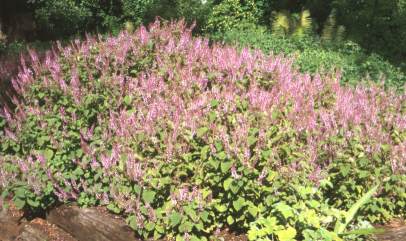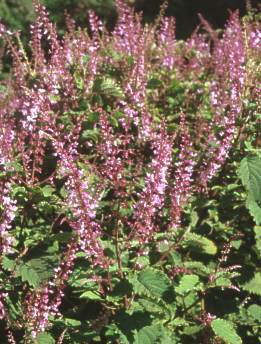Plectranthus fruticosus 'James'
Plectranthus fruticosus L'Hérit. 'James'
Family: Lamiaceae
Common names: Pink Spur Flower (E), Muishondblaar (A), Vlieëbos (A)
Introduction
Walking up the Camphor Avenue at Kirstenbosch during autumn it is difficult to miss the striking pink beds of Plectranthus fruticosus 'James'.

Beds of Plectranthus fruticosus 'James'
Description
Description
This plectranthus is a particularly attractive form of Plectranthus fruticosus, a shade-loving species with flowers mostly in shades of mauve but also in blue and pink. Compared to the species, Plectranthus fruticosus 'James' has smaller, more succulent leaves and pink flowers. It is a robust, fast-growing, upright, soft-wooded perennial that will reach a height of up to 2m. The leaves are very decorative, rich green in colour, softly hairy to the touch with margins that are attractively toothed and crinkled.

The veins are stained purple, particularly the midrib, and are very noticeable, particularly on the underside. The margins are also tinged with purple, so that even when not in flower, the beautiful foliage makes this cultivar a very decorative plant.
The striking inflorescence is an elongated branched terminal panicle, 80-250 mm long. Each little flower is pale pink speckled with purple, protruding from a deep pink to purple calyx which persists long after the flower has fallen. To add to the colour, the stem of the inflorescence is also stained purple. The inflorescences are held above the plant and are borne in profusion giving the overall effect of a very showy, misty haze in many shades of pink and purple. Flowering season begins in late summer (February) and peaks in autumn (March & April). The seed is a small smooth nutlet that can be seen inside the calyx attached to the base.
Another feature that distinguishes Plectranthus fruticosus 'James' from the species is its ability to take full sun. It is also much more tolerant of drought than Plectranthus fruticosus.
Like many members of the sage and mint family, the leaves and branches of Plectranthus fruticosus 'James' are aromatic, and release a pungent odour when touched or crushed. Whether pleasant or objectionable tends to be a matter of opinion. The Afrikaans common name, muishondblaar, means skunk leaf, and refers to this pungent odour. The name vlieëbos, which means fly-repellant bush, refers to the practice of using the plants odour to deter flies by keeping bunches of this plant in the house or rubbing leaves and stems on windowsills.
Distribution and habitat
Distribution description
Plectranthus fruticosus occurs in forests and shady rocky places from Caledon in the Western Cape to the Northern Province, now called the Limpopo Province. Plectranthus fruticosus 'James' is found at high altitudes (1000m+) on exposed rocky outcrops in an area around the Mpumalanga - Swaziland border.
Derivation of name and historical aspects
History
The genus Plectranthus is named from the Greek plektron, a spur, and anthos, a flower, referring to the base of the flower tube which is expanded near the base. The species name fruticosus is Latin for bushy or shrubby. Plectranthus fruticosus 'James' is named after James Culverwell, the conservationist who found this plant and brought it to the attention of Ernst van Jaarsveld who got it growing and introduced it to horticulture. There are roughly 300 species of Plectranthus spread throughout the tropical and warm regions of the old world with 45 species widespread in southern Africa, absent only from the Northern Cape.
Growing Plectranthus fruticosus 'James'
Grow
Plectranthus fruticosus 'James' is easy to grow. It is very effective when mass planted, but also makes an attractive shrub or container plant when planted singly or in threes. Plants flourish on the southern and eastern sides of houses (in the southern hemisphere) where they have sunlight for some of the day, but grow equally well in light shade under trees, next to shrubs or on the edge of a forest.
Unlike most species of Plectranthus, Plectranthus fruticosus 'James' will also thrive in full sun. It performs best in well-composted soil and although tolerant of prolonged periods of drought, a fuller more luxuriant plant will develop if given adequate water during summer.
Plectranthus fruticosus 'James' is frost tender, but will be able to survive occasional dips to -1oC / 4oF (USDA zone 10) or so. If it is cut down by frost, it will resprout in the spring, but it most likely will not be able to survive prolonged periods at freezing temperature and below.
To keep Plectranthus fruticosus 'James' neat, compact and bushy, it is best to prune plants back to between 1/3 and 1/4 of their height at the end of winter just before the new growth begins in spring. The stems should be neatly cut at an angle just above the nodes. After pruning is the ideal time to feed the plants and to dress the soil by applying a thick layer of compost or organic mulch and a dose of a balanced fertilizer. Both the pruning and the feeding will improve the quality of plants and stimulate flowering.
Plectranthus fruticosus 'James' is best propagated by means of cuttings. The best time for processing cuttings is in spring or summer when rooting is optimal. Softwood, semi-hardwood or tip cuttings can be taken from healthy plants. The ideal cutting is one with at least two nodes, 80-120 mm long. The bottom end of the cutting is cut beneath the node and the lower leaves are removed to prevent unnecessary moisture loss. Cuttings are placed in a container filled with washed coarse river sand or perlite.
The cuttings should not be dipped in rooting hormone or placed under mist irrigation as this can cause rotting, but should be placed in a shady spot, preferably under a roof and not be allowed to dry out. Cuttings will also root in a glass of water on a cool windowsill. Rooting takes place after 2-3 weeks, when plants are ready to be transplanted or potted up. Newly rooted plants should kept in a sheltered spot for 2-3 weeks before being planted into the garden.
Plectranthus fruticosus 'James' can also be propagated by seed sown in spring or summer. Use a suitable seed tray with adequate drainage holes. The seed tray should be filled with a soil mixture consisting of two parts leaf mould or peat moss, one part loam and one part sand well mixed. Plectranthus seed is very fine and should be broadcast evenly on the surface of the soil.
After sowing, cover with a thin layer of fine, clean river sand. Place the seed tray in a shady spot, under roof to prevent rain from washing away the seed. The seed trays are watered regularly to prevent the growing medium from drying out. Germination occurs in 2 to 4 weeks. The seedlings grow rapidly and require regular watering. Seedlings can be planted out into individual bags as soon as they are large enough to handle.
References
- Van Jaarsveld, Ernst, personal communication.
- Goldblatt, P. & Manning, J., 2000, Cape Plants, A Conspectus of the Cape Flora of South Africa, National Botanical Institute, Pretoria & Missouri Botanical Garden Press, Missouri
- Jackson, W.P.U., 1990, Origins and Meanings of Names of South African Plant Genera, U.C.T. Printing Dept., Cape Town.
- Smith, C.A., 1966, Common Names of South African Plants, Dept. of Agricultural Technical Services, Botanical Survey Memoir No 35, Government Printer.
- Leistner, O.A. (ed.), 2000, Seed plants of southern Africa: families and genera, Strelitzia 10., National Botanical Institute, Pretoria.
Credits
Norma Jodamus & Alice Notten
Kirstenbosch National Botanical Garden
April 2002
Plant Attributes:
Plant Type: Perennial
SA Distribution: Eastern Cape, Free State, Gauteng, KwaZulu-Natal, Limpopo, Mpumalanga, Western Cape
Soil type: Sandy
Flowering season: Late Summer, Autumn
PH:
Flower colour: Purple, Pink
Aspect: Full Sun, Shade, Morning Sun (Semi Shade), Afternoon Sun (Semi Shade)
Gardening skill: Easy
Special Features:
Horticultural zones











Rate this article
Article well written and informative
Rate this plant
Is this an interesting plant?
Login to add your Comment
Back to topNot registered yet? Click here to register.